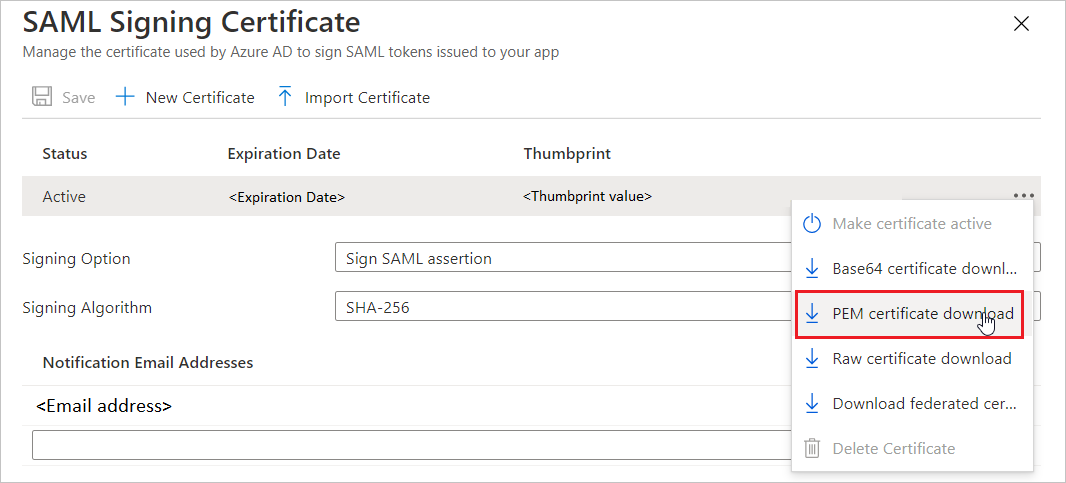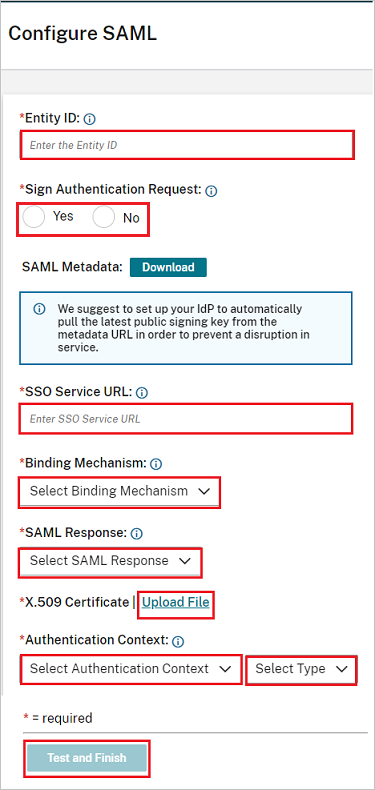Note
Access to this page requires authorization. You can try signing in or changing directories.
Access to this page requires authorization. You can try changing directories.
In this article, you learn how to integrate Citrix Cloud SAML SSO with Microsoft Entra ID. When you integrate Citrix Cloud SAML SSO with Microsoft Entra ID, you can:
- Control in Microsoft Entra ID who has access to Citrix Cloud SAML SSO.
- Enable your users to be automatically signed-in to Citrix Cloud SAML SSO with their Microsoft Entra accounts.
- Manage your accounts in one central location.
Prerequisites
The scenario outlined in this article assumes that you already have the following prerequisites:
- A Microsoft Entra user account with an active subscription. If you don't already have one, you can Create an account for free.
- One of the following roles:
- A Citrix Cloud subscription. If you don’t have a subscription, sign up for one.
Scenario description
In this article, you configure and test Microsoft Entra SSO in a test environment.
- Citrix Cloud SAML SSO supports SP initiated SSO.
Note
Identifier of this application is a fixed string value so only one instance can be configured in one tenant.
Add Citrix Cloud SAML SSO from the gallery
To configure the integration of Citrix Cloud SAML SSO into Microsoft Entra ID, you need to add Citrix Cloud SAML SSO from the gallery to your list of managed SaaS apps.
- Sign in to the Microsoft Entra admin center as at least a Cloud Application Administrator.
- Browse to Entra ID > Enterprise apps > New application.
- In the Add from the gallery section, type Citrix Cloud SAML SSO in the search box.
- Select Citrix Cloud SAML SSO from results panel and then add the app. Wait a few seconds while the app is added to your tenant.
Alternatively, you can also use the Enterprise App Configuration Wizard. In this wizard, you can add an application to your tenant, add users/groups to the app, assign roles, and walk through the SSO configuration as well. Learn more about Microsoft 365 wizards.
Configure and test Microsoft Entra SSO for Citrix Cloud SAML SSO
Configure and test Microsoft Entra SSO with Citrix Cloud SAML SSO using a test user called B.Simon. For SSO to work, you need to establish a link relationship between a Microsoft Entra user and the related user in Citrix Cloud SAML SSO. This user must also exist in your Active Directory that's synced with Microsoft Entra Connect to your Microsoft Entra subscription.
To configure and test Microsoft Entra SSO with Citrix Cloud SAML SSO, perform the following steps:
- Configure Microsoft Entra SSO - to enable your users to use this feature.
- Create a Microsoft Entra test user - to test Microsoft Entra single sign-on with B.Simon.
- Assign the Microsoft Entra test user - to enable B.Simon to use Microsoft Entra single sign-on.
- Configure Citrix Cloud SAML SSO - to configure the single sign-on settings on application side.
- Test SSO - to verify whether the configuration works.
Configure Microsoft Entra SSO
Follow these steps to enable Microsoft Entra SSO.
Sign in to the Microsoft Entra admin center as at least a Cloud Application Administrator.
Browse to Entra ID > Enterprise apps > Citrix Cloud SAML SSO > Single sign-on.
On the Select a single sign-on method page, select SAML.
On the Set up single sign-on with SAML page, select the pencil icon for Basic SAML Configuration to edit the settings.

On the Basic SAML Configuration section, perform the following step:
In the Sign-on URL text box, type a URL using the following pattern:
https://<SUBDOMAIN>.cloud.comNote
The value isn't real. Update the value with your Citrix Workspace URL. Access your Citrix Cloud account to get the value. You can also refer to the patterns shown in the Basic SAML Configuration section.
Citrix Cloud SAML SSO application expects the SAML assertions in a specific format, which requires you to add custom attribute mappings to your SAML token attributes configuration. The following screenshot shows the list of default attributes.

In addition to above, Citrix Cloud SAML SSO application expects few more attributes to be passed back in SAML response which are shown below. These attributes are also pre-populated but you can review them as per your requirements. The values passed in the SAML response should map to the Active Directory attributes of the user.
Name Source Attribute cip_sid user.onpremisesecurityidentifier cip_upn user.userprincipalname cip_oid ObjectGUID (Extension Attribute) cip_email user.mail displayName user.displayname Note
ObjectGUID must be configured manually according to your requirements.
On the Set up single sign-on with SAML page, in the SAML Signing Certificate section, find Certificate (PEM) and select Download to download the certificate and save it on your computer.

On the Set up Citrix Cloud SAML SSO section, copy the appropriate URL(s) based on your requirement.

Create and assign Microsoft Entra test user
Follow the guidelines in the create and assign a user account quickstart to create a test user account called B.Simon.
Configure Citrix Cloud SAML SSO
In a different web browser window, sign in to your up Citrix Cloud SAML SSO company site as an administrator
Navigate to the Citrix Cloud menu and select Identity and Access Management.

Under Authentication, locate SAML 2.0 and select Connect from the ellipsis menu.
In the Configure SAML page, perform the following steps.

a. In the Entity ID textbox, paste the Microsoft Entra Identifier value which you copied previously.
b. In the Sign Authentication Request, select Yes, if you want to use
SAML Request signing, else select No.c. In the SSO Service URL textbox, paste the Login URL value which you copied previously.
d. Select Binding Mechanism from the drop-down, you can select either HTTP-POST or HTTP-Redirect binding.
e. Under SAML Response, select Sign Either Response or Assertion from the dropdown.
f. Upload the Certificate (PEM) into the X.509 Certificate section.
g. In the Authentication Context, select Unspecified and Exact from the dropdown.
h. Select Test and Finish.
Test SSO
In this section, you test your Microsoft Entra single sign-on configuration with following options.
Access your Citrix Workspace URL directly and initiate the login flow from there.
Log in with your AD-Synced Active Directory user into your Citrix Workspace to complete the test.
Related content
Once you configure Citrix Cloud SAML SSO you can enforce session control, which protects exfiltration and infiltration of your organization’s sensitive data in real time. Session control extends from Conditional Access. Learn how to enforce session control with Microsoft Defender for Cloud Apps.